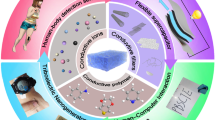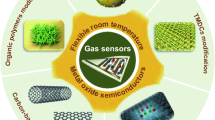Abstract
Sensitivity toward humidity, response and recovery time, and reproducibility behaviors of a novel copolymer sensor, obtained by oxidative chemical polymerization of o-phenylenediamine and aniline using D-camphor-10-sulfonic acid dopant, were reported. It is a novel copolymer, and there are very few studies available concerning its synthesis and humidity sensing applications. Humidity-sensitive properties of the copolymer were tested by measuring the resistance of the fabricated films, and good humidity sensitivity was obtained. Moreover, a decrease in resistance with the increase in humidity was observed. Compared to polyaniline (PANI), the humidity sensing property of the copolymer was found to show quicker response and recovery time, higher reproducibility, and higher sensitivity. However, PANI alone exhibited relatively poor sensing property. The response time for the copolymer films at the relative humidity ranging from 11 to 97% was about 38 s, and the corresponding recovery time was about 11 s. The value of sensitivity was about 10. These results indicate excellent sensing character of the new type of copolymer humidity sensors. The obtained sensor is expected to exhibit good humidity sensing behavior in moisture-containing environment.








Similar content being viewed by others
References
Hsu C-L, Su IL, Hsueh T-J (2017) Tunable Schottky contact humidity sensor based on S-doped ZnO nanowires on flexible PET substrate with piezotronic effect. J Alloy Compd 705:722–733
Zhang D, Jiang C, Sun Y (2017) Room-temperature high-performance ammonia gas sensor based on layer-by-layer self-assembled molybdenum disulfide/zinc oxide nanocomposite film. J Alloy Compd 698:476–483
Xu JM, Cheng JP (2016) The advances of Co3O4 as gas sensing materials: a review. J Alloy Compd 686:753–768
Seki T, Tanaka K, Ichimura K (1997) Photomechanical response in monolayered polymer films on mica at high humidity. Macromolecules 30:6401–6403
Park MS, Lim TH, Jeon YM, Kim JG, Joo SW, Gong MS (2008) A facile and simple method for the preparation of copoly(TEAMPS/VP)/silver nanocomposites for the humidity-sensing membranes. J Colloid Interface Sci 321:60–66
Sun Y-L, Wu R-J, Huang Y-C, Su P-G, Chavali M, Chen Y-Z, Lin C-C (2007) In situ prepared polypyrrole for low humidity QCM sensor and related theoretical calculation. Talanta 73:857–861
Shoji E, Hirayama D (2007) Effects of humidity on the performance of ionic polymer-metal composite actuators: experimental study of the back-relaxation of actuators. J Phys Chem B 111:11915–11920
Biju KP, Jain MK (2007) Effect of polyethylene glycol additive in sol on the humidity sensing properties of a TiO2 thin film. Meas Sci Technol 18:2991–2996
Kuang Q, Lao C, Wang ZL, Xie Z, Zheng L (2007) High-sensitivity humidity sensor based on a single SnO2 nanowire. J Am Chem Soc 129:6070–6071
Li Z, Zhang H, Zheng W, Wang W, Huang H, Wang C, MacDiarmid AG, Wei Y (2008) Highly sensitive and stable humidity nanosensors based on LiCl added TiO2 electrospun nanofibers. J Am Chem Soc 130:5036–5037
Wang JG (2002) Polyaniline coatings: anionic membrane nature and bipolar structures for anticorrosion. Synth Met 132:53–56
Soto-Oviedo MA, Araujo OA, Faez R, Rezende MC, De Paoli M-A (2006) Antistatic coating and electromagnetic shielding properties of a hybrid material based on polyaniline/organoclay nanocomposite and EPDM rubber. Synth Met 156:1249–1255
Grgur BN, Ristic V, Gvozdenovic MM, Maksimovic MD, Jugovic BZ (2008) Polyaniline as possible anode materials for the lead acid batteries. J Power Sour 180:635–640
Li Z-F, Blum FD, Bertino MF, Kim C-S, Pillalamarri SK (2008) One-step fabrication of a polyaniline nanofiber vapor sensor. Sens Actuators B 134:31–35
Ayad MM, Salahuddin NA, Abou-Seif AK, Alghaysh MO (2008) pH sensor based on polyaniline and aniline-anthranilic acid copolymer films using quartz crystal microbalance and electronic absorption spectroscopy. Polym Adv Technol 19:1142–1148
Borole DD, Kapadi UR, Mahulikar PP, Hundiwale DG (2004) Electrochemical behavior of polyaniline, poly(o-anisidine) and their copolymer thin films in inorganic and organic supporting electrolytes. Polym Plast Technol Eng 43:1443–1458
Zhang G-R, Xu C-T, Zhang A-J, Chen L, Lu J-X (2008) Study on. electrochemical copolymerization of aniline with p-phenylenediamine on ITO electrode by in situ UV–Vis spectroscopy and characterization of the copolymer. Acta Chim Sinica 66:376–384
Lu J-F, Wang L, Lai Q-Y, Chu H-Y, Zhao Y (2009) Study of capacitive properties in supercapacitor for copolymer of aniline with m-phenylenediamine. J Solid State Electrochem 13:1803–1810
Li X-G, Wang H-Y, Huang M-R (2007) Synthesis, film-forming, and electronic properties of o-phenylenediamine copolymers displaying an uncommon tricolor. Macromolecules 40:1489–1496
Jain S, Chakane S, Samui AB, Krishnamurthy VN, Bhoraskar SV (2003) Humidity sensing with weak acid-doped polyaniline and its composites. Sens Actuators B 96:124–129
Kulkarni MV, Viswanath AK (2005) Spectroscopic, thermal and electrical properties of sulphonic acids doped poly(o-anisidine) and their application as humidity sensor. Sens Actuators B 107:791–797
Tonosaki T, Oho T, Isomura K, Ogura K (2002) Effect of the protonation level of poly(o-phenylenediamine) (PoPD) on the ac impedance of humidity-sensitive PoPD/poly(vinyl alcohol) composite film. J Electroanal Chem 520:89–93
Patil D, Seo YK, Hwang YK, Chang JS, Patil P (2008) Humidity sensitive poly(2,5-dimethoxyaniline)/WO3 composites. Sens Actuators B 132:116–124
Zhou TL, Xie XH, Cai JY, Yin LY, Ruan WD (2016) Preparation of poly(o-toluidine)/TiO2 nanocomposite films and application for humidity sensing. Polym Bull 73:621–630
Zhang LJ, Wan MX (2005) Chiral polyaniline nanotubes synthesized via a self-assembly process. Thin Solid Films 477:24–31
Kulkarni MV, Viswanath AK, Marimuthu R, Seth T (2004) Synthesis and characterization of polyaniline added with organic acids. J Polym Sci Pol Chem 42:2043–2049
Kulkarni MV, Viswanath AK, Marimuthu R, Seth T (2004) Spectroscopic, transport, and morphological studies of polyaniline added with inorganic acids. Polym Eng Sci 44:1676–1681
Lu X, Mao H, Chao D, Zhao X, Zhang W, Wei Y (2007) Preparation and characterization of poly(o-phenylenediamine) microrods using ferric chloride as an oxidant. Mater Lett 61:1400–1403
Wang L, Guo S, Dong S (2008) Facile synthesis of poly(o-phenylenediamine) microfibrils using cupric sulfate as the oxidant. Mater Lett 62:3240–3242
Ginic-Markovic M, Matisons JG, Cervini R, Simon GP, Fredericks PM (2006) Synthesis of new polyaniline/nanotube composites using ultrasonically initiated emulsion polymerization. Chem Mater 18:6258–6265
Zhang H, Li HX, Cheng HM (2006) Water-soluble multiwalled carbon nanotubes functionalized with sulfonated polyaniline. J Phys Chem B 110:9095–9099
Mazeikiene R, Malinauskas A (2002) The stability of poly (o-phenylenediamine) as an electrode material. Synth Met 128:121–125
Mallick K, Witcomb MJ, Erasmus R, Scurrell MS (2007) Hydrophilic behaviour of gold-poly (o-phenylenediamine) hybrid nanocomposite. Mater Sci Eng, B 140:166–171
Travers JP, Nechtschein M (1987) Water effects in polyaniline: a new conduction process. Synth Met 21:135–141
Pinto NJ, Shah PD, Kahol P, McCormick BJ (1996) Conducting state of polyaniline films: dependence on moisture. Phys Rev B 53:10690–10694
Matveeva ES (1996) Residual water as a factor influencing the electrical properties of polyaniline. The role of hydrogen bonding of the polymer with solvent molecules in the formation of a conductive polymeric network. Synth Met 79:127–139
Zeng FW, Liu XX, Diamond D, Lau KT (2010) Humidity sensors based on polyaniline nanofibres. Sens Actuators B 143:530–534
Acknowledgements
The study was supported by the Natural Science Foundation of China (Grant No. 21103062) and the Korean Federation of Science and Technology Societies (KOFST) Grant funded by the Korean government (MSIP: Ministry of Science, ICT and Future Planning). W. R. is grateful to the Postdoctoral Science Foundation of China (Grant No. 2014M561286).
Author information
Authors and Affiliations
Corresponding authors
Additional information
Publisher's Note
Springer Nature remains neutral with regard to jurisdictional claims in published maps and institutional affiliations.
Rights and permissions
About this article
Cite this article
Zhou, T., Wu, S., Cai, J. et al. Rapid humidity sensors based on poly(o-phenylenediamine-co-aniline) spherical nanoparticles. Polym. Bull. 77, 1095–1105 (2020). https://doi.org/10.1007/s00289-019-02794-z
Received:
Revised:
Accepted:
Published:
Issue Date:
DOI: https://doi.org/10.1007/s00289-019-02794-z




